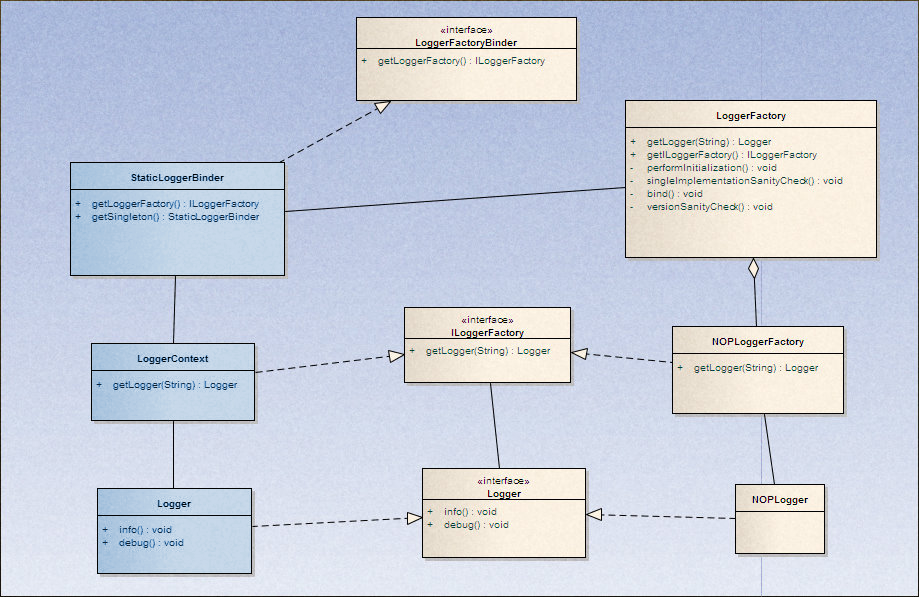查看源码的建议:
1、源代码的类虽然很多,但是一般是有一个清晰的结构的(当然有些项目确实结构混乱,东一撮西一撮的,那没关系,不读就是了)。所以在深入到具体的细节之前,应该先把整个代码的结构梳理清楚,再一块一块地往下读。梳理清楚了脉络和结构,可以直接跳过不想深究的细节,只要知道它是干什么的就行了,当用到的时候再来看
2、源代码的类虽然很多,但是一般会有一个入口。比如hibernate的SessionFactory,spring的ApplicationContext,logback的LoggerFactory。从入口进去,一点点地读,必要的时候使用debug功能跟着走一走,相信会清晰很多
以前我就是进了误区,哎
slf4j最关键的是2个接口,和一个入口类。搞清楚了这3个,对slf4j就会比较清楚了。
最关键的2个接口,分别是Logger和ILoggerFactory。
最关键的入口类,是LoggerFactory
所有的具体实现框架,一定会实现Logger接口和ILoggerFactory接口。前者实际记录日志,后者用来提供Logger,重要性不言自明。而LoggerFactory类,则是前面说过的入口类。
private final static Logger LOGGER = LoggerFactory.getLogger(RequestController.class);
不管实现框架是什么,要获取Logger对象,都是通过这个类的getLogger()方法,所以这个类也非常重要。具体实现框架和slf4j的对接,就是通过这个类

如图,每个日志框架都需要实现ILoggerFactory接口,来说明自己是怎么提供Logger的。像log4j、logback能够提供父子层级关系的Logger,就是在ILoggerFactory的实现类里实现的。同时,它们也需要实现Logger接口,以完成记录日志。为啥log4j和logback可以一个Logger对应多个Appender?这就要去分析它们的Logger实现类。
slf4j自带的NOPLoggerFactory,实现了ILoggerFactory,其getLogger()方法很简单,就是返回一个NOPLogger
public class NOPLoggerFactory implements ILoggerFactory { public NOPLoggerFactory() { // nothing to do } public Logger getLogger(String name) { return NOPLogger.NOP_LOGGER; } }
NOPLogger实现了Logger接口,它就更简单,如同它的名字一样:什么都不做

public class NOPLogger extends MarkerIgnoringBase { private static final long serialVersionUID = -517220405410904473L; /** * The unique instance of NOPLogger. */ public static final NOPLogger NOP_LOGGER = new NOPLogger(); /** * There is no point in creating multiple instances of NOPLogger, * except by derived classes, hence the protected access for the constructor. */ protected NOPLogger() { } /** * Always returns the string value "NOP". */ public String getName() { return "NOP"; } /** * Always returns false. * @return always false */ final public boolean isTraceEnabled() { return false; } /** A NOP implementation. */ final public void trace(String msg) { // NOP } /** A NOP implementation. */ final public void trace(String format, Object arg) { // NOP } /** A NOP implementation. */ public final void trace(String format, Object arg1, Object arg2) { // NOP } /** A NOP implementation. */ public final void trace(String format, Object... argArray) { // NOP } /** A NOP implementation. */ final public void trace(String msg, Throwable t) { // NOP } /** * Always returns false. * @return always false */ final public boolean isDebugEnabled() { return false; } /** A NOP implementation. */ final public void debug(String msg) { // NOP } /** A NOP implementation. */ final public void debug(String format, Object arg) { // NOP } /** A NOP implementation. */ public final void debug(String format, Object arg1, Object arg2) { // NOP } /** A NOP implementation. */ public final void debug(String format, Object... argArray) { // NOP } /** A NOP implementation. */ final public void debug(String msg, Throwable t) { // NOP } /** * Always returns false. * @return always false */ final public boolean isInfoEnabled() { // NOP return false; } /** A NOP implementation. */ final public void info(String msg) { // NOP } /** A NOP implementation. */ final public void info(String format, Object arg1) { // NOP } /** A NOP implementation. */ final public void info(String format, Object arg1, Object arg2) { // NOP } /** A NOP implementation. */ public final void info(String format, Object... argArray) { // NOP } /** A NOP implementation. */ final public void info(String msg, Throwable t) { // NOP } /** * Always returns false. * @return always false */ final public boolean isWarnEnabled() { return false; } /** A NOP implementation. */ final public void warn(String msg) { // NOP } /** A NOP implementation. */ final public void warn(String format, Object arg1) { // NOP } /** A NOP implementation. */ final public void warn(String format, Object arg1, Object arg2) { // NOP } /** A NOP implementation. */ public final void warn(String format, Object... argArray) { // NOP } /** A NOP implementation. */ final public void warn(String msg, Throwable t) { // NOP } /** A NOP implementation. */ final public boolean isErrorEnabled() { return false; } /** A NOP implementation. */ final public void error(String msg) { // NOP } /** A NOP implementation. */ final public void error(String format, Object arg1) { // NOP } /** A NOP implementation. */ final public void error(String format, Object arg1, Object arg2) { // NOP } /** A NOP implementation. */ public final void error(String format, Object... argArray) { // NOP } /** A NOP implementation. */ final public void error(String msg, Throwable t) { // NOP } }
下面就是关键的LoggerFactory类了,这个入口类是怎么提供Logger的呢?
首先它调用一个public的getILoggerFactory()方法,获得一个ILoggerFactory的实现类,然后委托这个实现类提供一个Logger实现类。就是这样把获取实际Logger的工作,委托给具体的日志框架上,比如log4j、logback、common-logging等
/** * 返回正在使用的 {@link ILoggerFactory} 实例。 * ILoggerFactory 实例在编译时与此类绑定。 * @return 正在使用的 ILoggerFactory 实例 */ public static ILoggerFactory getILoggerFactory() { if (INITIALIZATION_STATE == UNINITIALIZED) { // 使用锁的方式保证初始化和校验的安全性 synchronized (LoggerFactory.class) { if (INITIALIZATION_STATE == UNINITIALIZED) { INITIALIZATION_STATE = ONGOING_INITIALIZATION; // 执行初始化 performInitialization(); } } } switch (INITIALIZATION_STATE) { case SUCCESSFUL_INITIALIZATION: return StaticLoggerBinder.getSingleton().getLoggerFactory(); case NOP_FALLBACK_INITIALIZATION: return NOP_FALLBACK_FACTORY; case FAILED_INITIALIZATION: throw new IllegalStateException(UNSUCCESSFUL_INIT_MSG); case ONGOING_INITIALIZATION: // support re-entrant behavior. // See also http://jira.qos.ch/browse/SLF4J-97 return SUBST_FACTORY; } throw new IllegalStateException("Unreachable code"); }
为了获得ILoggerFactory的实现类,它首先要初始化,它会委托NOPLoggerFactory来提供Logger,最终结果就是一个没实现的NOPLogger。如果初始化成功了,就是和日志框架对接成功,就委托日志框架的ILoggerFactory来提供Logger的实现。
private final static void performInitialization() { bind(); if (INITIALIZATION_STATE == SUCCESSFUL_INITIALIZATION) { versionSanityCheck(); } }
然后是关键的bind()方法,绑定实现框架。最后再检查一下版本完整性。这段代码提到了一个最关键的StaticLoggerBinder类,检查是否有这个类存在,检查是否有这个是否是Android 应用,以及这个类有没有getSingleton()方法,如果有,就视为绑定成功(起码 self4j的实现导入了)。其实这个类还必须有getLoggerFactory()方法,否则虽然绑定成功,但是到了运行期,一样会抛出NoSuchMethodException。我认为这里是slf4j设计不好的地方,应该在bind()方法里,就检查一下StaticLoggerBinder有没有实现getLoggerFactory()方法。
private final static void bind() { try { Set<URL> staticLoggerBinderPathSet = null; // skip check under android, see also // http://jira.qos.ch/browse/SLF4J-328 if (!isAndroid()) { staticLoggerBinderPathSet = findPossibleStaticLoggerBinderPathSet(); reportMultipleBindingAmbiguity(staticLoggerBinderPathSet); } // the next line does the binding StaticLoggerBinder.getSingleton(); INITIALIZATION_STATE = SUCCESSFUL_INITIALIZATION; reportActualBinding(staticLoggerBinderPathSet); } catch (NoClassDefFoundError ncde) { String msg = ncde.getMessage(); if (messageContainsOrgSlf4jImplStaticLoggerBinder(msg)) { INITIALIZATION_STATE = NOP_FALLBACK_INITIALIZATION; Util.report("Failed to load class \"org.slf4j.impl.StaticLoggerBinder\"."); Util.report("Defaulting to no-operation (NOP) logger implementation"); Util.report("See " + NO_STATICLOGGERBINDER_URL + " for further details."); } else { failedBinding(ncde); throw ncde; } } catch (java.lang.NoSuchMethodError nsme) { String msg = nsme.getMessage(); if (msg != null && msg.contains("org.slf4j.impl.StaticLoggerBinder.getSingleton()")) { INITIALIZATION_STATE = FAILED_INITIALIZATION; Util.report("slf4j-api 1.6.x (or later) is incompatible with this binding."); Util.report("Your binding is version 1.5.5 or earlier."); Util.report("Upgrade your binding to version 1.6.x."); } throw nsme; } catch (Exception e) { failedBinding(e); throw new IllegalStateException("Unexpected initialization failure", e); } finally { postBindCleanUp(); } }
这个StaticLoggerBinder类,就是具体实现框架和slf4j框架对接的接口。

这就介绍完了logback是怎么和slf4j对接的。不止是logback,任何日志框架,一定都是通过自己的StaticLoggerBinder类,来和slf4j对接。这个类的实现,在不同的框架中不同,比如后面会说到,在logback中,这个类被设计为或者简单的返回一个默认的LoggerContext(LoggerContext是ILoggerFactory在logback中的实现),或者通过ContextSelector(logback特有的)来选择一个LoggerContext并返回。
大家可能会有一个疑问:在LoggerFactory类的bind()方法里,依赖了StaticLoggerBinder类,但是slf4j框架里又没有这个类,那么框架一开始是怎么编译通过并发布成jar包的呢?

作者一开始的时候,是以类似图里的包结构组织代码的。为了编译通过,作者写了一个StaticLoggerBinder类
private final ILoggerFactory loggerFactory; private StaticLoggerBinder() { loggerFactory = new NOPLoggerFactory(); } public ILoggerFactory getLoggerFactory() { return loggerFactory; }
然后,作者把org.slf4j、org.slf4j.helpers、org.slf4j.spi这3个package发布为slf4j-api.jar。把org.slf4j.impl发布为slf4j-nop.jar
用户实际使用的时候,必须要引入slf4j-api.jar和具体实现框架,比如log4j.jar,以及对接用的slf4j-log4j.jar,不需要引入slf4j-nop.jar
博客来源:
由于使用的版本较高,本文稍有不同,新版本中也见到很多新的编程思想


